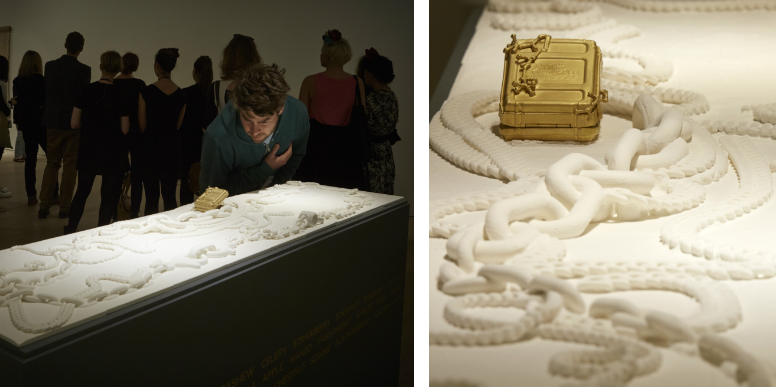Artist Katrin Spranger wants to bring the issue of colony collapse disorder (CCD) worldwide to the forefront. While many of us know something’s up with bees that we should be worrying about, most don’t have time to focus on in-depth research. It’s pretty simple though, and it’s also an issue that’s cropped up numerous times in history, recorded over the last couple hundred years.
Crops are where the true worry lies, when inspecting the human agenda behind many reports. While we are certainly sorry to lose any of the industrious, fascinating bees, the bottom line is that when they disappear, it can affect agriculture substantially.
Spranger uses the 3D printed liquid gold as an avenue to point out what a commodity honey itself is. Together, she and the 3dChef team were able to spin its sweet goodness into a showstopping piece of art, “The Future of Apis Melifera,” that depicts the precious metal amidst a gilt jewelry box.
“Armed with little more than [an] old school collage and a brief meeting, 3dChef set to work digitally designing this complex piece down to every last link, claw, and clasp,” Sing reported on his blog. “Designing the piece was only [half] the story. The other was making the parts print out in this untried material, honey. Before too long we nailed it and the results even amazed us. The detail, the crispness and strength were perfect.”
The EPA stresses how important it is that pesticides, when used, are always administered correctly, and that along with many other aspects and concerns, that bees are considered as well. Because their lack of presence means lack of pollination to crops, they can seriously affect an economy.
Spranger certainly made a statement for the bees, with size, talent, and taste. The artwork, said to be the largest 3D printed edible known (by 3dChef), was shown off to incredulous viewers at the Saatchi Gallery in London, who were truly shocked and delighted at the end of the exhibit when the glass case was lifted off and those in attendance were allowed to take pieces of the 3D printed honey to taste. One hopes that with each delectable bite they were considering the plight of our precious honey bee.
Discuss your thoughts on the way Spranger used 3D printed art–and edible materials–to shed light on an important cause. Have you tried any 3D printed food or sweets? Share with us in the 3D Printed Honey Artwork forum thread over at 3DPB.com.
